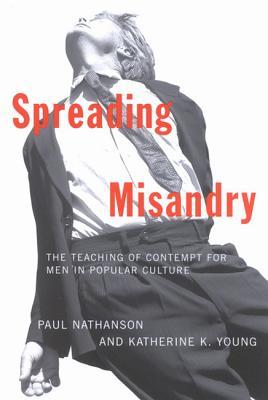We hear much about misogyny (woman-hating) these days but far less about misandry (man-hating). Spreading Misandry, coauthored by a woman who has written extensively on women’s issues, identifies negative stereotypes and double standards that harm not only men but society as a whole. Paul Nathanson and Katherine K. Young document the hostility toward, and contempt for, men that pervade our films, TV shows, universities, cartoons—even our greeting cards. This book turns the table on the sex wars.
Misogyny is considered morally and even legally unacceptable. Not so misandry. Most people ignore it, excuse it, trivialize it, or even justify it, as the sex gap grows ever wider. The problem of sexual polarization must be faced, however, not only because tolerating it is inherently dangerous but because overcoming it is inherently good.
This book avoids the emotional outbursts and charges that dominate much recent scholarship and characterize many texts and journals. It is meticulously researched and carefully documented: There are 50 pages of notes and references. The goal is to make clear that society has not only silenced men but dehumanized them to such an extent that many men now find it difficult to recognize their own humanity.
Fostered by political correctness, misandry dominated the 1990’s and shows no signs of abating in the new century. It has been actively promoted in academic and political circles, featured on talk shows, and given free reign in popular films and on television (especially in commercials). Popular culture has both mediated and fostered the teaching of contempt for men. The revolution has been successful because, as Marxists would say, the new values are now firmly embedded in everyday life. We hardly see them, let alone challenge them.
The first three chapters discuss relatively “benign” forms of misandry: laughing at men, looking down on them, and by-passing them. These were initial strategies in countering the “plot” (history as a titanic conspiracy of men usurping power from women, oppressing them, and covering up the ugly truth). The more dangerous lines of attack involve the deliberate falsification of evidence to make political claims about sex—the claim that men are ontologically evil and that bad boys end up being beasts. The authors provide numerous examples from film, television, popular culture, and feminists tracts.
The “new order,” based on “feminist values” or “women’s spirituality,” would merely substitute matriarchy, in some form, for patriarchy. In this brave new world, males would be carefully controlled and duly punished for deviating from the prescribed norm. This world can be achieved only by social engineering on a colossal scale. Several observers have noted obvious ways in which feminist ideology is quasireligious in nature. Like both religious fundamentalism and Marxism, it has an answer for every challenge.
What strategies have been concocted to achieve these goals? Three main ones, Nathanson and Young contend: political correctness, deconstruction, and “fronts” (rhetoric used to conceal ideas and goals that would otherwise be unacceptable). For example, pluralism, diversity, and multiculturalism make ideal fronts for radical feminism, each celebrating ethnic and sexual differences rather than human universals. All of these strategies pit “us” against “them”: “They” deserve nothing but public ridicule and attack. At the same time, it is now unthinkable, especially for public figures, to ridicule or attack women. (It is perfectly respectable for women to ridicule or attack men.) As a result, men are often silenced as effectively as women allegedly once were silenced. There are also more specific fronts for feminist ideology—reform as a front for revolution and anger as a front for hatred. Anger is an emotion; hatred is a worldview.
The authors’ ultimate goal, they claim, is to reverse the current polarization of men and women by laying the foundation for a new social contract between the sexes—one that takes seriously the distinctive needs and problems of both sexes. In the end, our society will have to find ways of solving the pervasive and destructive problem of sexual dualism.
[Spreading Misandry: The Teaching of Contempt for Men in Popular Culture, by Paul Nathanson and Katherine K. Young (Montreal: McGill-Queen’s University Press) 370 pp., $29.95]

Leave a Reply